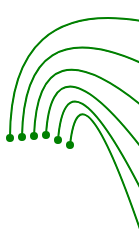The state of the art in the diagnosis of Alzheimer's disease has already been discussed in detail in the menu item “Subject of the project” – “Explanation of the topic”.
There is a growing recognition that Alzheimer's disease is a “systemic disease” in which several non-linear “set screws” seem to exist, so that the previous scientific narrative regarding amyloid-β as the cause of AD must be relativized at least by its claimed general significance. Consequently, (imaging) diagnostics (MRI, PET), which are primarily focused on the presence of amyloid-β plaques, must also be viewed at least critically with regard to the therapeutic consequences of their results. Since the cognitive signs of deterioration are often already very pronounced when imaging diagnostics is used, there can be no question of early diagnosis in these cases. On the other hand, the well-founded hypothesis has been put forward that “precursors” of AD already occur 18 years before the full expression of AD symptoms, which should therefore also be reflected early in the EEG. However, EEG analyses are currently still used to a minor extent for the diagnosis of AD, since a usually complex mathematical analysis of the EEG time series is required here and the specificity was and is not considered sufficient for a sole EEG diagnosis.
However, with the help of the EEG analysis, which can be performed without any health risk for the patient, different stages of AD, as well as the differentiation to MCI and its transition to AD can be distinguished, which will be used in this project.
EEG analysis offers great advantages, because it allows differentiation between e.g. MCI (mild cognitive impairment, unspecific of which type) and AD, so that the EEG signal is a comparatively simple bio-marker for AD. It is known [1], that in the case of the presence of AD, a higher "power" is measured in the EEG time series in the low frequency range (delta-, theta-band, < 15 Hz), whereas in the higher frequency range (~ 30-40 Hz, alpha- and beta-bands) a lower "power" is measured, especially in certain brain regions. It is precisely this EEG measurement indicating the presence of AD that will be used in the project, in conjunction with the results of the other diagnostic sub-modules of the physician module (neuropsychological test set, writing, speech, personal context, smelling), to achieve both high specificity and sensitivity in the early diagnosis of AD.
Besides an extension of the spectral feature space of the EEG signals, as it has been done according to Fraga et al. [2] by analyzing the amplitude modulation of the EEG signals in the frequency bands relevant for AD, the work "EEG oscillations during word processing predict MCI conversion to Alzheimer's disease" by A. Mazaheri et al.[3] should be mentioned in particular. The basic statement of Mazaheri's work is that during a test that asks whether or not a linguistic category (e.g. "type of wood") corresponds to the presentation of an image (e.g. "oak"), an EEG examination is performed simultaneously. This makes it possible to distinguish between different groups (AD, MCI, converters from MCI to AD, control persons). In the IASON project, precisely this test is to be used in combination with the other sub-modules mentioned above to provide a quantitative basis for the prognosis of the transition from MCI to AD (after all, 40% of MCI patients develop AD).
For further currently relevant topics of the state of science for the IASON project, please refer to the menu item "Updates on the state of the art".
Further developments will be referred to in the next version of this project page in autumn 2020.
References:
- ↑ J. Dauwels et al, „Slowing and loss of complexity in Alzheimer’s EEG: two sides of the same coin?”, SAGE-Hindawi Access to Research, International Journal of Alzheimer’s Disease, Volume 2011, Article ID 539621, doi:10.4061/2011/539621, https://www.hindawi.com/journals/ijad/2011/539621/
- ↑ F. Fraga et al, „Characterizing Alzheimers's disease severity via resting-awake EEG amplitude modulation analysis”, (2013), PLoS ONE https://doi.org/10.1371/journal.pone.0072240
- ↑ A. Mazaheri et al, “EEG oscillations during word processing predict MCI conversion to Alzheimer's disease”, NeuroImage: Clinical 17 (2018), p. 188-197, Elsevier https://www.sciencedirect.com/science/article/pii/S2213158217302504


 English
English  Deutsch
Deutsch